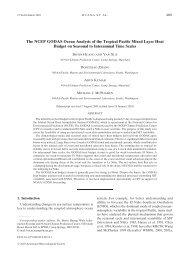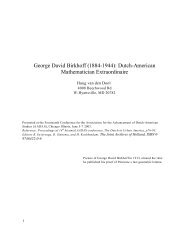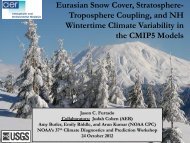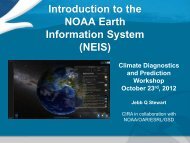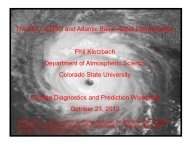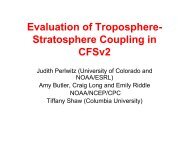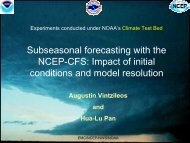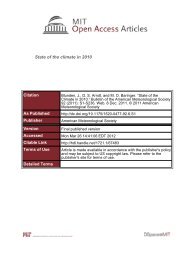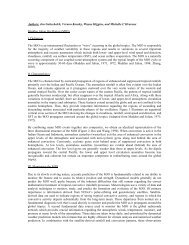Seasonality of the Pacific decadal oscillation - Climate Prediction ...
Seasonality of the Pacific decadal oscillation - Climate Prediction ...
Seasonality of the Pacific decadal oscillation - Climate Prediction ...
You also want an ePaper? Increase the reach of your titles
YUMPU automatically turns print PDFs into web optimized ePapers that Google loves.
AMERICAN<br />
METEOROLOGICAL<br />
SOCIETY<br />
Journal <strong>of</strong> <strong>Climate</strong><br />
EARLY ONLINE RELEASE<br />
This is a preliminary PDF <strong>of</strong> <strong>the</strong> author-produced<br />
manuscript that has been peer-reviewed and<br />
accepted for publication. Since it is being posted<br />
so soon after acceptance, it has not yet been<br />
copyedited, formatted, or processed by AMS<br />
Publications. This preliminary version <strong>of</strong> <strong>the</strong><br />
manuscript may be downloaded, distributed, and<br />
cited, but please be aware that <strong>the</strong>re will be visual<br />
differences and possibly some content differences<br />
between this version and <strong>the</strong> final published version.<br />
The DOI for this manuscript is doi: 10.1175/2011JCLI4092.1<br />
The final published version <strong>of</strong> this manuscript will replace<br />
<strong>the</strong> preliminary version at <strong>the</strong> above DOI once it is available.<br />
© 2011<br />
American Meteorological Society
<strong>Seasonality</strong> <strong>of</strong> <strong>the</strong> <strong>Pacific</strong> Decadal Oscillation<br />
HUI WANG 1,2 , ARUN KUMAR 1 , WANQIU WANG 1 , and YAN XUE 1<br />
1 <strong>Climate</strong> <strong>Prediction</strong> Center, NCEP/NWS/NOAA, Camp Springs, Maryland<br />
2 Wyle Information Systems, McLean, Virginia<br />
Journal <strong>of</strong> <strong>Climate</strong><br />
Manuscript submitted 20 September 2010<br />
Revised 29 January 2011 and 17 May 2011<br />
Corresponding author address: Dr. Hui Wang, NOAA <strong>Climate</strong> <strong>Prediction</strong> Center,<br />
5200 Auth Road, Camp Springs, MD 20746.<br />
E-mail: hui.wang@noaa.gov
ABSTRACT<br />
The seasonality <strong>of</strong> <strong>the</strong> <strong>Pacific</strong> <strong>decadal</strong> <strong>oscillation</strong> (PDO) is examined using North<br />
<strong>Pacific</strong> sea surface temperature (SST) in observations and in a 480-yr simulation with <strong>the</strong><br />
National Centers for Environmental <strong>Prediction</strong> (NCEP) <strong>Climate</strong> Forecast System (CFS)<br />
coupled model. The PDO, both in observations and in <strong>the</strong> CFS, shows similar<br />
seasonality, with increasing SST variance during spring and a maximum in late spring<br />
and early summer. The vertical structure <strong>of</strong> <strong>the</strong> ocean temperature anomaly associated<br />
with <strong>the</strong> PDO in <strong>the</strong> CFS displays a significant transition from a deep to a shallow<br />
structure during late spring, consistent with <strong>the</strong> seasonal variation <strong>of</strong> <strong>the</strong> mean ocean<br />
mixed layer depth (MLD). An analysis <strong>of</strong> atmospheric surface wind and SST anomalies<br />
from <strong>the</strong> CFS simulation indicates that <strong>the</strong>re is a 1-month delay in <strong>the</strong> PDO-related SST<br />
response to <strong>the</strong> atmospheric wind forcing. The results based <strong>the</strong> CFS simulation are<br />
generally consistent with observations, including both atmospheric data from <strong>the</strong><br />
NCEP/Department <strong>of</strong> Energy (DOE) Reanalysis 2 (R2) and ocean data from <strong>the</strong> NCEP<br />
Global Ocean Data Assimilation System (GODAS). The 1-month delay toge<strong>the</strong>r with <strong>the</strong><br />
seasonal variation <strong>of</strong> <strong>the</strong> mean MLD tends to amplify <strong>the</strong> PDO-related SST response to<br />
<strong>the</strong> atmospheric surface wind in late spring to early summer, and leads to <strong>the</strong> maximum<br />
variability <strong>of</strong> <strong>the</strong> PDO, which is a 3-month delay from <strong>the</strong> peak phase <strong>of</strong> <strong>the</strong> surface wind<br />
in February and March.<br />
1
1. Introduction<br />
The <strong>Pacific</strong> <strong>decadal</strong> <strong>oscillation</strong> (PDO) is <strong>the</strong> leading empirical orthogonal function<br />
(EOF) <strong>of</strong> monthly mean sea surface temperature (SST) anomalies in <strong>the</strong> North <strong>Pacific</strong><br />
(Mantua et al. 1997; Zhang et al. 1997). The causes <strong>of</strong> <strong>the</strong> PDO are <strong>the</strong> subject <strong>of</strong> many<br />
previous studies. Proposed mechanisms responsible for <strong>the</strong> spatial and temporal<br />
characteristics <strong>of</strong> <strong>the</strong> PDO include stochastic forcing <strong>of</strong> <strong>the</strong> ocean by <strong>the</strong> atmosphere<br />
(Alexander 2010), coupling <strong>of</strong> <strong>the</strong> midlatitude ocean-atmosphere system (Barnett et al.<br />
1999), <strong>the</strong> reemergence <strong>of</strong> deep oceanic mixed layer temperature anomaly leading to a<br />
multi-year persistence <strong>of</strong> <strong>the</strong> PDO (Alexander et al. 1999), tropical forcing by <strong>the</strong> El<br />
Niño–Sou<strong>the</strong>rn Oscillation (ENSO; Newman et al. 2003; An et al. 2007; Shakun and<br />
Shaman 2009), and <strong>the</strong> variability <strong>of</strong> <strong>the</strong> Aleutian low and Kuroshio Extension (Qiu<br />
2003; Schneider and Cornuelle 2005), among o<strong>the</strong>rs.<br />
Similar to ENSO, <strong>the</strong> PDO is associated with broad impacts on global climate<br />
(Mantua and Hare 2002). However, unlike <strong>the</strong> influence <strong>of</strong> ENSO, <strong>the</strong> PDO-related<br />
precipitation and temperature anomalies in North America are not strongest in winter<br />
(Minobe 2000; Cayan et al. 2001; Hu and Huang 2009). It is also well known that<br />
tropical SST variability related to ENSO influences <strong>the</strong> PDO through <strong>the</strong> atmospheric<br />
bridge mechanism (Alexander et al. 2002). Specifically, ENSO can significantly alter <strong>the</strong><br />
variability <strong>of</strong> <strong>the</strong> Aleutian low. The latter in turn affects <strong>the</strong> PDO. Fur<strong>the</strong>rmore, this<br />
“tropical-extratropical” linkage between ENSO and <strong>the</strong> PDO occurs on interannual timescales,<br />
and is likely to follow <strong>the</strong> seasonality in <strong>the</strong> evolution <strong>of</strong> both ENSO SST<br />
anomalies in <strong>the</strong> tropical <strong>Pacific</strong> and <strong>the</strong> characteristics <strong>of</strong> tropical-extratropical<br />
teleconnection (Newman and Sardeshmukh, 1998).<br />
2
The PDO can also modulate <strong>the</strong> impact <strong>of</strong> ENSO on extratropical climate (e.g.,<br />
Gershunov and Barnett 1998; Wang et al. 2008; Birk et al. 2010) by altering <strong>the</strong><br />
background mean flow (on which tropical-extratropical teleconnection depend) on<br />
<strong>decadal</strong> time-scales. Fur<strong>the</strong>r, based on <strong>the</strong> seasonality <strong>of</strong> <strong>the</strong> PDO, such a modulation<br />
may also have a seasonality.<br />
What factors determine <strong>the</strong> characteristic seasonal evolution <strong>of</strong> <strong>the</strong> PDO With<br />
much focus on <strong>the</strong> low-frequency evolution <strong>of</strong> <strong>the</strong> PDO, seasonal variations in <strong>the</strong> PDO<br />
characteristics have received less attention. Diagnosis and budget analysis with oceanic<br />
models indicate that atmospheric heat flux (Dawe and Thompson 2007), <strong>the</strong> variability <strong>of</strong><br />
<strong>the</strong> Aleutian low and anomalous advection <strong>of</strong> mean SST (Chhak et al. 2009) are<br />
important for <strong>the</strong> seasonal evolution <strong>of</strong> <strong>the</strong> PDO. However, <strong>the</strong> understanding is far from<br />
comprehensive. A better understanding <strong>of</strong> <strong>the</strong> seasonality <strong>of</strong> <strong>the</strong> PDO is important for<br />
potential improvements in our understanding <strong>of</strong> its predictability and prediction skill, its<br />
global associations, and its <strong>decadal</strong> modulation <strong>of</strong> <strong>the</strong> impact <strong>of</strong> ENSO on extratropical<br />
climate.<br />
This study aims to characterize <strong>the</strong> seasonality <strong>of</strong> <strong>the</strong> PDO and potential<br />
mechanisms. Our hypo<strong>the</strong>sis is that <strong>the</strong> PDO seasonality is dominated by <strong>the</strong> combined<br />
influence <strong>of</strong> <strong>the</strong> seasonal variations in <strong>the</strong> atmospheric forcing and oceanic mixed layer<br />
depth (MLD). Our emphasis is on <strong>the</strong> PDO evolution from spring to summer because as<br />
will be shown, <strong>the</strong>re are significant changes in 1) <strong>the</strong> seasonal characteristics <strong>of</strong> <strong>the</strong><br />
PDO, and 2) <strong>the</strong> strength <strong>of</strong> <strong>the</strong> atmospheric forcing and MLD between <strong>the</strong> two seasons,<br />
both <strong>of</strong> which play an important role in <strong>the</strong> variability <strong>of</strong> midlatitude SST (Alexander and<br />
Penland 1996).<br />
3
2. Data<br />
Our analysis is based on data from observations and a coupled model simulation.<br />
As will be shown, <strong>the</strong> spatial pattern and seasonality <strong>of</strong> <strong>the</strong> PDO are similar between<br />
observations and <strong>the</strong> coupled model simulation. Use <strong>of</strong> <strong>the</strong> model simulation allows us to<br />
investigate <strong>the</strong> seasonality <strong>of</strong> <strong>the</strong> PDO based on a longer and more consistent oceanatmosphere<br />
model data set.<br />
The SST used in this study includes observational data from <strong>the</strong> National Oceanic<br />
and Atmospheric Administration (NOAA) Optimum Interpolation SST (OISST) V2<br />
(Reynolds et al. 2002), NOAA Extended Reconstructed SST (ERSST) V3b (Reynolds et<br />
al. 2007), and simulated data from <strong>the</strong> National Centers for Environmental <strong>Prediction</strong><br />
(NCEP) <strong>Climate</strong> Forecast System (CFS; Saha et al. 2006) coupled model. The OISST is<br />
on a 1 o × 1 o (latitude × longitude) grid and over 29 years from 1982 to 2010. The 29-yr<br />
period <strong>of</strong> <strong>the</strong> satellite observations may be too short to represent PDO. The ERSST, with<br />
a longer record is also employed, which is on a 2 o × 2 o (latitude × longitude) grid and<br />
over 150 years from 1861 to 2010. The SST from <strong>the</strong> CFS is on a 1 o × 2 o (latitude ×<br />
longitude) grid. The CFS was initialized with January 1, 1981 conditions obtained from<br />
<strong>the</strong> NCEP/Department <strong>of</strong> Energy (DOE) Reanalysis 2 (R2; Kanamitsu et al. 2002) for <strong>the</strong><br />
atmosphere and from <strong>the</strong> NCEP Global Ocean Data Assimilation System (GODAS;<br />
Behringer and Xue 2004) for <strong>the</strong> oceans. The coupled model was integrated for 500<br />
years. The last 480 years are used in <strong>the</strong> analysis. Data from <strong>the</strong> model simulation is<br />
divided into 16 segments <strong>of</strong> 30-yr periods. Each shorter-period segment is comparable<br />
with <strong>the</strong> 29 years in <strong>the</strong> OISST, and <strong>the</strong> analysis <strong>of</strong> PDO seasonality over 16 such<br />
4
ealizations provides an estimate <strong>of</strong> variability in results due to sampling (as may be <strong>the</strong><br />
case for <strong>the</strong> OISST).<br />
The CFS is a fully coupled ocean–atmosphere–land model, and was implemented<br />
for operational seasonal forecast at NCEP in 2004. The present version <strong>of</strong> <strong>the</strong> CFS has a<br />
horizontal resolution <strong>of</strong> T62 and 64 vertical levels in <strong>the</strong> atmospheric component <strong>of</strong> <strong>the</strong><br />
model. This dynamical forecast system has demonstrated skillful seasonal forecasts for a<br />
number <strong>of</strong> important climate phenomena, including ENSO (Wang et al. 2005; Zhang et<br />
al. 2007), <strong>the</strong> Asian-Australian monsoon (Wang et al. 2008), and <strong>the</strong> North American<br />
monsoon (Yang et al. 2009). A detailed description <strong>of</strong> model physics and an overview <strong>of</strong><br />
CFS performance can be found in Saha et al. (2006) and Wang et al. (2010).<br />
Oceanic and atmospheric fields from <strong>the</strong> CFS are utilized to analyze <strong>the</strong>ir roles in<br />
<strong>the</strong> PDO seasonal variation. Ocean temperatures (5–300 m) resolved with 26 vertical<br />
levels in <strong>the</strong> CFS are used to characterize <strong>the</strong> vertical structure <strong>of</strong> <strong>the</strong> PDO and to derive<br />
<strong>the</strong> MLD. The latter is critical to <strong>the</strong> effectiveness <strong>of</strong> SST response to atmospheric<br />
forcing (Alexander and Penland 1996). The MLD is estimated as <strong>the</strong> depth at which <strong>the</strong><br />
temperature change from <strong>the</strong> ocean surface is 0.5 o C (Monterey and Levitus 1997). The<br />
atmospheric field from <strong>the</strong> CFS is inferred from <strong>the</strong> 1000-hPa wind on a 2.5 o × 2.5 o<br />
(latitude × longitude) grid. The results based on <strong>the</strong> CFS simulation are compared to<br />
ocean temperature and 1000-hPa wind at <strong>the</strong> same resolutions from <strong>the</strong> GODAS and R2,<br />
respectively, for <strong>the</strong> period from 1982 to 2010. Surface fluxes, including latent, sensible,<br />
long wave, short wave, and Ekman heat transport from <strong>the</strong> CFS simulation are also<br />
employed to illustrate <strong>the</strong>ir seasonal variations with <strong>the</strong> PDO. The contribution to change<br />
in surface heat flux due to Ekman transport is estimated using zonal and meridional<br />
5
surface wind stress from <strong>the</strong> CFS outputs, as well as zonal and meridional SST gradients<br />
derived from <strong>the</strong> CFS (e.g., Alexander and Scott 2008). All data are monthly means.<br />
The PDO is identified as <strong>the</strong> first EOF <strong>of</strong> North <strong>Pacific</strong> SST between 20 o N and<br />
65 o N based on <strong>the</strong> covariance matrix <strong>of</strong> <strong>the</strong> SST anomalies. Similar to Mantua et al.<br />
(1997) and Zhang et al. (1997), <strong>the</strong> global mean SST anomaly is removed prior to <strong>the</strong><br />
EOF analysis for <strong>the</strong> PDO, to suppress <strong>the</strong> influence <strong>of</strong> <strong>the</strong> trend <strong>of</strong> global mean SST.<br />
The spatial structure <strong>of</strong> <strong>the</strong> PDO in <strong>the</strong> CFS is <strong>the</strong> ensemble mean <strong>of</strong> <strong>the</strong> 16 different<br />
realizations <strong>of</strong> <strong>the</strong> first EOF mode <strong>of</strong> North <strong>Pacific</strong> SST based on <strong>the</strong> individual 30-yr<br />
long segments.<br />
3. Results<br />
a. <strong>Seasonality</strong> <strong>of</strong> <strong>the</strong> PDO<br />
Figures 1a, 1b, and 1c show <strong>the</strong> spatial patterns <strong>of</strong> SST associated with <strong>the</strong> first<br />
EOF <strong>of</strong> monthly mean SST anomalies over <strong>the</strong> North <strong>Pacific</strong> in <strong>the</strong> OISST and ERSST<br />
data sets and <strong>the</strong> CFS simulation, respectively. This mode accounts for 23% <strong>of</strong> North<br />
<strong>Pacific</strong> SST variance in both <strong>the</strong> OISST and ERSST, and on average 21% in <strong>the</strong> CFS<br />
simulation. To some extent <strong>the</strong> PDO pattern is similar to <strong>the</strong> ENSO pattern but with<br />
higher loading in <strong>the</strong> North <strong>Pacific</strong>. The pattern correlation coefficient between <strong>the</strong> PDO<br />
in <strong>the</strong> observations and that in <strong>the</strong> CFS ensemble mean is 0.88 and 0.91 for <strong>the</strong> OISST<br />
and ERSST, respectively. The average correlation coefficient between <strong>the</strong> observations<br />
and 16 individual 30-yr segments is 0.81 (OISST) and 0.84 (ERSST).<br />
We note that <strong>the</strong>re might be nonstationarity (or variability due to sampling) in <strong>the</strong><br />
structure <strong>of</strong> <strong>the</strong> PDO. As displayed in Fig. 1, <strong>the</strong> PDO pattern in <strong>the</strong> OISST (Fig. 1a) has<br />
6
more connection with SST variability in <strong>the</strong> western tropical <strong>Pacific</strong> than <strong>the</strong> ERSST and<br />
CFS (Figs. 1b and 1c). A closer inspection reveals that similar connection between <strong>the</strong><br />
PDO and SST in <strong>the</strong> western tropical <strong>Pacific</strong> can also be found in <strong>the</strong> ERSST when using<br />
most recent 30-yr data, and also in some individual CFS 30-yr segments. This suggests<br />
that <strong>the</strong> difference in <strong>the</strong> PDO structure between <strong>the</strong> OISST and ERSST or CFS may be<br />
due to sampling, and <strong>the</strong> short period <strong>of</strong> <strong>the</strong> OISST analysis.<br />
The seasonality <strong>of</strong> <strong>the</strong> PDO, both in <strong>the</strong> observations and <strong>the</strong> CFS, is quantified<br />
by <strong>the</strong> distribution <strong>of</strong> <strong>the</strong> fraction (%) <strong>of</strong> total SST variance explained by <strong>the</strong> principal<br />
component (PC) time series over 12 calendar months, as shown in Fig. 1d. It is a<br />
measure <strong>of</strong> <strong>the</strong> seasonal variation <strong>of</strong> <strong>the</strong> amplitude <strong>of</strong> <strong>the</strong> PDO pattern. The amplitude <strong>of</strong><br />
<strong>the</strong> PDO in <strong>the</strong> OISST and ERSST increases from winter to spring, reaches peak values<br />
in May and June, and <strong>the</strong>n declines during summer, with a secondary maximum in fall.<br />
The relatively strong variance in summer and weak variance in winter are consistent with<br />
<strong>the</strong> finding <strong>of</strong> Zhang et al. (1998). For comparison, <strong>the</strong> seasonality based on <strong>the</strong> PDO<br />
index (Mantua et al. 1997) for 1900–2010 (available at http://jisao.washington.edu/pdo<br />
/PDO.latest) is also plotted in Fig. 1d, which was derived from <strong>the</strong> leading PC <strong>of</strong> monthly<br />
North <strong>Pacific</strong> SST using <strong>the</strong> UK Meteorological Office Historical SST data (Parker et al.<br />
1995) for 1900–81 and <strong>the</strong> OISST for 1982–2010. This particular PDO index shows<br />
peak variability in June and July. However, it also shows strong variability in<br />
December–February that is not found in <strong>the</strong> OISST and ERSST. The difference may be<br />
due to different SST datasets.<br />
The PDO <strong>of</strong> <strong>the</strong> CFS ensemble mean displays a seasonality with a peak in June,<br />
with relatively higher variability in summer and lower variability in winter and fall. The<br />
7
peaks <strong>of</strong> <strong>the</strong> PDO variability in individual members vary from May to July. Overall, <strong>the</strong><br />
seasonal distribution <strong>of</strong> <strong>the</strong> percentage variance for <strong>the</strong> PDO in <strong>the</strong> observations is well<br />
within <strong>the</strong> spread <strong>of</strong> 16 CFS ensemble members, except for <strong>the</strong> Mantua et al. (1997) PDO<br />
index in May and June.<br />
Figure 1 suggests that both <strong>the</strong> spatial pattern and seasonality <strong>of</strong> <strong>the</strong> PDO in <strong>the</strong><br />
CFS resemble those in <strong>the</strong> 150-yr ERSST more than those in <strong>the</strong> 29-yr OISST. That<br />
<strong>the</strong>se features are simulated reasonably well in <strong>the</strong> CFS coupled integration allows us to<br />
use <strong>the</strong> data over a 480-yr period for fur<strong>the</strong>r analysis. The following analysis focuses on<br />
<strong>the</strong> ensemble mean <strong>of</strong> 16 30-yr CFS coupled runs from months <strong>of</strong> January to August and<br />
comparisons with <strong>the</strong> observations, including <strong>the</strong> 29-yr (1982–2010) GODAS data,<br />
OISST, and R2 reanalysis data.<br />
The seasonality in <strong>the</strong> amplitude <strong>of</strong> <strong>the</strong> PDO is also reflected in <strong>the</strong> vertical<br />
structure <strong>of</strong> ocean temperature anomalies associated with <strong>the</strong> PDO. Figure 2 shows <strong>the</strong><br />
depth–longitude cross-section <strong>of</strong> <strong>the</strong> PDO-related monthly mean ocean temperature<br />
anomalies at 37 o N from January to August and <strong>the</strong> correlation between ocean temperature<br />
and <strong>the</strong> PC time series in <strong>the</strong> CFS. The anomalies are obtained by regressing monthly<br />
mean ocean temperature anomalies onto <strong>the</strong> PC time series <strong>of</strong> each 30-yr segment for<br />
each calendar month and <strong>the</strong>n averaging regression patterns over <strong>the</strong> 16 such regression<br />
patterns. The correlation coefficients are also averaged over 16 individual 30-yr<br />
segments. Latitude 37 o N is <strong>the</strong> location at which <strong>the</strong> PDO SST anomaly has <strong>the</strong> largest<br />
amplitude (Fig. 1).<br />
Figure 2 indicates that colder ocean temperature anomalies greater than 0.4 o C<br />
penetrate to <strong>the</strong> depth <strong>of</strong> about 150 m during winter (January and February). In March<br />
8
and April <strong>the</strong> cold temperature anomalies can reach deeper layers over 250 m. In late<br />
spring, <strong>the</strong>re is an abrupt decrease in <strong>the</strong> depth <strong>of</strong> <strong>the</strong> temperature anomalies colder than<br />
0.4 o C. These anomalies are confined above 150 m in May, and become progressively<br />
shallower during summer.<br />
Near <strong>the</strong> ocean surface, temperature anomalies also display strong seasonal<br />
variation (Fig. 2), consistent with <strong>the</strong> seasonality <strong>of</strong> <strong>the</strong> PDO shown in Fig. 1d. In<br />
January and February <strong>the</strong> cold temperature anomalies are relatively weak. During March<br />
and April <strong>the</strong> amplitude <strong>of</strong> <strong>the</strong> anomalies near <strong>the</strong> dateline starts to increase. The colder<br />
anomalies are zonally widespread at <strong>the</strong> surface in May and June. The correlation<br />
coefficient between <strong>the</strong> ocean temperature and <strong>the</strong> PC time series generally exceeds –0.5<br />
in <strong>the</strong> regions with cold temperature anomalies great than 0.4 o C. These results suggest<br />
that <strong>the</strong> seasonal variation <strong>of</strong> <strong>the</strong> PDO is closely related to <strong>the</strong> seasonal changes in <strong>the</strong><br />
vertical structure <strong>of</strong> <strong>the</strong> ocean temperature anomalies underneath.<br />
Similar composite and correlation analyses are also performed for ocean<br />
temperature from <strong>the</strong> 29-yr GODAS data against <strong>the</strong> leading PC <strong>of</strong> <strong>the</strong> OISST in <strong>the</strong><br />
North <strong>Pacific</strong>, and are shown in Fig. 3. Despite much shallower temperature anomalies<br />
during March and April in <strong>the</strong> GODAS data, <strong>the</strong> seasonal changes in <strong>the</strong> vertical structure<br />
<strong>of</strong> <strong>the</strong> ocean temperature anomalies associated with <strong>the</strong> PDO in <strong>the</strong> CFS (Fig. 2) resemble<br />
those in <strong>the</strong> GODAS (Fig. 3).<br />
b. Explaining PDO seasonality: The role <strong>of</strong> seasonal variations <strong>of</strong> <strong>the</strong> MLD and<br />
atmospheric forcing<br />
9
The ocean mixed layer plays an important role in <strong>the</strong> reemergence <strong>of</strong> SST<br />
anomalies in <strong>the</strong> North <strong>Pacific</strong> (Alexander et al. 1999; Deser et al. 2003) and SST<br />
changes associated with <strong>the</strong> PDO (Carton et al. 2008). In this section we show that <strong>the</strong><br />
mean seasonal cycle <strong>of</strong> <strong>the</strong> MLD is also important in determining <strong>the</strong> timing <strong>of</strong> <strong>the</strong><br />
maximum variability <strong>of</strong> <strong>the</strong> PDO.<br />
Figure 4 shows <strong>the</strong> 16-member ensemble mean <strong>of</strong> 30-yr climatological MLD<br />
from January to August derived from <strong>the</strong> 480-yr CFS coupled simulation. The seasonal<br />
variation <strong>of</strong> <strong>the</strong> mixed layer is characterized by deep MLD in winter and early spring and<br />
shallow MLD in May and summer. The MLD experiences a sharp decrease from more<br />
than 100 m in April to less than 50 m in May over most <strong>of</strong> <strong>the</strong> North <strong>Pacific</strong>. The<br />
seasonal change in <strong>the</strong> vertical structure <strong>of</strong> <strong>the</strong> ocean temperature anomalies associated<br />
with <strong>the</strong> PDO (Fig. 2) exhibits similar sharp decrease in <strong>the</strong> depth <strong>of</strong> <strong>the</strong> temperature<br />
anomalies from April to May and likely follows <strong>the</strong> seasonal variation <strong>of</strong> <strong>the</strong> MLD.<br />
The transition from a deep to shallow mixed layer during late spring is also<br />
observed in 29-yr climatological MLD in <strong>the</strong> GODAS data shown in Fig. 5. Compared<br />
to <strong>the</strong> GODAS data, <strong>the</strong> climatological MLD in <strong>the</strong> CFS is slightly deeper between 25 o N<br />
and 40 o N and north <strong>of</strong> 50 o N, and slightly shallower between 40 o N and 50 o N during<br />
January through April. Overall, <strong>the</strong> observed seasonal variation <strong>of</strong> <strong>the</strong> mean MLD is well<br />
simulated in <strong>the</strong> CFS.<br />
Previous studies have also suggested that atmospheric surface wind is likely<br />
responsible for <strong>the</strong> evolution <strong>of</strong> PDO-related SST anomalies (e.g., Newman et al. 2003;<br />
Miller et al. 2004; Carton et al. 2008). To explore <strong>the</strong> contribution <strong>of</strong> surface wind<br />
forcing in generating PDO seasonality, EOF analysis is performed for 1000-hPa zonal<br />
10
wind over <strong>the</strong> North <strong>Pacific</strong> region to identify <strong>the</strong> dominant mode <strong>of</strong> <strong>the</strong> atmospheric<br />
circulation variability. Figure 6 shows <strong>the</strong> regression patterns <strong>of</strong> 1000-hPa wind anomaly<br />
for individual months from January to August reconstructed based on <strong>the</strong> first EOF <strong>of</strong><br />
1000-hPa zonal wind toge<strong>the</strong>r with <strong>the</strong> SST anomaly reconstructed based on <strong>the</strong> leading<br />
EOF <strong>of</strong> <strong>the</strong> North <strong>Pacific</strong> SST (Fig. 1c) in <strong>the</strong> CFS.<br />
The surface wind exhibits a basinwide cyclonic circulation over <strong>the</strong> North <strong>Pacific</strong><br />
associated with <strong>the</strong> variability <strong>of</strong> <strong>the</strong> Aleutian low. The wind pattern is very similar to<br />
that <strong>of</strong> Chhak et al. (2009) associated with <strong>the</strong> PDO. The budget analysis in Chhak et al.<br />
(2009) suggests that anomalous horizontal advection <strong>of</strong> mean SST by anomalous Ekman<br />
transport contributes primarily to <strong>the</strong> PDO-related SST pattern. In addition, <strong>the</strong><br />
distribution <strong>of</strong> <strong>the</strong> surface wind in Fig. 6 can also be used to infer partially <strong>the</strong> winddriven<br />
SST anomalies related to <strong>the</strong> PDO. For example, sou<strong>the</strong>rly and sou<strong>the</strong>asterly<br />
wind anomalies along <strong>the</strong> west coast <strong>of</strong> North America and over <strong>the</strong> Gulf <strong>of</strong> Alaska<br />
induce an onshore Ekman transport that suppresses upwelling and warms <strong>the</strong> ocean<br />
mixed layer. In <strong>the</strong> central North <strong>Pacific</strong> to <strong>the</strong> south <strong>of</strong> 40 o N, westerly wind anomalies<br />
cool <strong>the</strong> ocean surface by increasing evaporation and heat flux from <strong>the</strong> ocean to <strong>the</strong><br />
atmosphere (Cayan 1992a,b). Overall, both <strong>the</strong> warm and cold SST anomalies in <strong>the</strong><br />
North <strong>Pacific</strong> are dynamically consistent with <strong>the</strong> surface wind pattern, indicating <strong>the</strong><br />
PDO-related SST anomalies are likely driven by <strong>the</strong> dominant mode <strong>of</strong> <strong>the</strong> atmospheric<br />
circulation. It is noted also that <strong>the</strong> surface wind anomalies are strongest in February and<br />
March, whereas <strong>the</strong> SST anomalies are strongest in May and June.<br />
Figure 7 shows <strong>the</strong> reconstructed 1000-hPa wind and SST anomalies associated<br />
with <strong>the</strong>ir corresponding leading EOFs using <strong>the</strong> 29-yr (1982–2010) 1000-hPa wind from<br />
11
R2 and <strong>the</strong> OISST data. The pattern correlation coefficient for <strong>the</strong> first EOF <strong>of</strong> 1000-hPa<br />
zonal wind between <strong>the</strong> CFS ensemble mean and R2 is 0.98. The SST anomalies are<br />
generally stronger in <strong>the</strong> observations (Fig. 7) than in <strong>the</strong> CFS (Fig. 6), with more cold<br />
SST anomalies in <strong>the</strong> western subtropical North <strong>Pacific</strong> and warm SST anomalies in <strong>the</strong><br />
eastern subtropics. In addition, as compared to <strong>the</strong> observations, <strong>the</strong> center <strong>of</strong> maximum<br />
cold SST anomalies in <strong>the</strong> CFS is shifted towards <strong>the</strong> west along 40 o N. This is probably<br />
a systematic bias <strong>of</strong> <strong>the</strong> CFS in representing <strong>the</strong> PDO spatial pattern. Overall, both <strong>the</strong><br />
spatial distribution <strong>of</strong> wind and SST anomalies and <strong>the</strong>ir seasonal variation <strong>of</strong> <strong>the</strong><br />
intensity <strong>of</strong> <strong>the</strong>se anomalies in <strong>the</strong> CFS (Fig. 6) are consistent with <strong>the</strong> observations (Fig.<br />
7).<br />
The cause and effect relationship between <strong>the</strong> surface wind and SST anomalies is<br />
fur<strong>the</strong>r investigated from <strong>the</strong> lead and lag correlation between <strong>the</strong> two PC time series <strong>of</strong><br />
<strong>the</strong> first EOF <strong>of</strong> <strong>the</strong> 1000-hPa zonal wind and SST anomalies, as shown in Fig. 8, for both<br />
<strong>the</strong> CFS and observations. Significant correlations are found when <strong>the</strong> zonal wind leads<br />
<strong>the</strong> SST up to two months, but correlations are weak when <strong>the</strong> zonal wind lags <strong>the</strong> SST.<br />
The strongest correlation occurs for <strong>the</strong> zonal wind leading <strong>the</strong> SST by one month. The<br />
results imply that <strong>the</strong> time scale for <strong>the</strong> SST response to atmospheric wind forcing is<br />
about one month, consistent with <strong>the</strong> finding <strong>of</strong> Deser and Timlin (1997) that <strong>the</strong> time<br />
scale for mid-latitude ocean mixed layer in response to atmospheric stochastic forcing is<br />
approximately 2–3 weeks based on <strong>the</strong> analysis <strong>of</strong> weekly data.<br />
To illustrate <strong>the</strong> importance <strong>of</strong> <strong>the</strong> interaction between <strong>the</strong> atmospheric forcing<br />
and <strong>the</strong> MLD on <strong>the</strong> seasonality <strong>of</strong> <strong>the</strong> PDO, shown in Figs. 9a and 9b are <strong>the</strong> seasonal<br />
variation <strong>of</strong> area-averaged monthly 1000-hPa zonal wind variance associated with <strong>the</strong><br />
12
first EOF <strong>of</strong> <strong>the</strong> 1000-hPa zonal wind and <strong>the</strong> evolution <strong>of</strong> <strong>the</strong> MLD over <strong>the</strong> North<br />
<strong>Pacific</strong> domain. The surface zonal wind in <strong>the</strong> CFS displays strong seasonality with <strong>the</strong><br />
largest variability in February and March consistent with <strong>the</strong> large wind anomaly in <strong>the</strong>se<br />
two months (Fig. 6). The atmospheric forcing is thus strong in February and March and<br />
weak in summer. The variability <strong>of</strong> surface zonal wind in <strong>the</strong> observations exhibits quite<br />
similar seasonal variation. It is stronger than in <strong>the</strong> CFS during November through<br />
January and weaker during February through October, with a peak in February. The<br />
MLD in both <strong>the</strong> observation and CFS also shows a similar seasonality with <strong>the</strong> deepest<br />
depth in February or March and shallowest in summer.<br />
Variations in <strong>the</strong> surface wind forcing alone clearly cannot explain <strong>the</strong> peak <strong>of</strong> <strong>the</strong><br />
PDO variability in May and June. Since it is <strong>the</strong> mixed layer in <strong>the</strong> upper ocean that<br />
directly responds to <strong>the</strong> atmospheric forcing, <strong>the</strong> MLD is also expected to play an<br />
important role in determining <strong>the</strong> effectiveness <strong>of</strong> SST response to <strong>the</strong> atmospheric<br />
forcing. To illustrate this, Fig. 9c shows <strong>the</strong> seasonal variation <strong>of</strong> <strong>the</strong> square root <strong>of</strong> <strong>the</strong><br />
zonal wind variance divided by <strong>the</strong> MLD. The square root <strong>of</strong> <strong>the</strong> zonal wind variance<br />
denotes <strong>the</strong> amplitude <strong>of</strong> <strong>the</strong> zonal wind anomaly and thus <strong>the</strong> amplitude <strong>of</strong> atmospheric<br />
forcing. As divided by <strong>the</strong> MLD, <strong>the</strong> value is approximately proportional to <strong>the</strong> forcing<br />
per unit mass for <strong>the</strong> mixed layer over which <strong>the</strong> influence <strong>of</strong> atmospheric forcing gets<br />
distributed and affects <strong>the</strong> SST anomaly. Given that it takes about one month for <strong>the</strong> SST<br />
to respond to <strong>the</strong> atmospheric forcing, <strong>the</strong> values plotted in Fig. 9c for month N are<br />
obtained by using <strong>the</strong> MLD in month N and <strong>the</strong> zonal wind variance in previous month<br />
N–1. The rate <strong>of</strong> <strong>the</strong> zonal wind variance square root to <strong>the</strong> MLD in <strong>the</strong> CFS peaks in<br />
June as <strong>the</strong> PDO variability in Fig. 1d. This implies that <strong>the</strong> 1-month time scale for <strong>the</strong><br />
13
SST to respond to <strong>the</strong> atmospheric forcing, shallow MLD in summer, and relatively<br />
strong atmospheric forcing in spring, are critical to <strong>the</strong> timing <strong>of</strong> <strong>the</strong> maximum variability<br />
<strong>of</strong> <strong>the</strong> PDO in late spring and early summer. It is interesting to note that <strong>the</strong> rate for <strong>the</strong><br />
observations in Fig. 9c peaks in May and June, consistent with <strong>the</strong> largest PDO<br />
variability in <strong>the</strong> OISST in <strong>the</strong> same months (Fig. 1d).<br />
The mechanism proposed in this study may not work for explaining <strong>the</strong> relative<br />
peak in <strong>the</strong> variability <strong>of</strong> <strong>the</strong> PDO in <strong>the</strong> fall season (Fig. 1d). There are many o<strong>the</strong>r<br />
factors that may control <strong>the</strong> seasonality <strong>of</strong> <strong>the</strong> PDO, including <strong>the</strong> tropical influence<br />
related to <strong>the</strong> ENSO and seasonal variation <strong>of</strong> surface fluxes. To investigate <strong>the</strong><br />
influence <strong>of</strong> variation in surface heat fluxes, Fig. 10 shows <strong>the</strong> seasonal change in<br />
monthly mean variance averaged over <strong>the</strong> North <strong>Pacific</strong> associated with <strong>the</strong> PC time<br />
series <strong>of</strong> <strong>the</strong> PDO in <strong>the</strong> CFS, including latent and sensible heat fluxes, net long wave and<br />
short wave radiation fluxes, and heat flux due to Ekman heat transport. Both <strong>the</strong> latent<br />
and sensible heat fluxes (Figs. 10a and 10b) are characterized by maximum variance in<br />
February and March, consistent with <strong>the</strong> largest variance <strong>of</strong> surface wind in <strong>the</strong> same<br />
months (Fig. 9a). The variance <strong>of</strong> <strong>the</strong>se fluxes is low in summer, but increases again<br />
during fall. Thus, <strong>the</strong>se surface heat fluxes could become increasingly important in<br />
determining <strong>the</strong> variability <strong>of</strong> <strong>the</strong> PDO during fall. For subsequent winter when MLD is<br />
largest, large variations in heat flux may not contribute to PDO variability.<br />
The variance <strong>of</strong> long wave and short wave radiation fluxes also displays a<br />
distinctive seasonality (Fig. 10c). The seasonal change in variance <strong>of</strong> long wave flux is<br />
relatively small (note a different scale in Fig. 10c). Unlike o<strong>the</strong>r surface fluxes, <strong>the</strong><br />
variance <strong>of</strong> short wave flux exhibits peaks in April–July, with values comparable to latent<br />
14
heat flux. This indicates that short wave radiation in late spring and early summer could<br />
contribute more to <strong>the</strong> variability <strong>of</strong> <strong>the</strong> PDO than in o<strong>the</strong>r seasons. Norris et al. (1998)<br />
found that summertime low clouds tend to be negatively correlated with local SST in <strong>the</strong><br />
North <strong>Pacific</strong> because changes in cloudiness can significantly affect surface short wave<br />
radiation flux. They also found a strong link between cloudiness and <strong>the</strong> leading EOF <strong>of</strong><br />
sea level pressure. The latter is likely tied to <strong>the</strong> variability <strong>of</strong> <strong>the</strong> Aleutian low and <strong>the</strong><br />
related surface wind shown in Figs. 6 and 7. Never<strong>the</strong>less, <strong>the</strong> seasonal change in <strong>the</strong><br />
variance <strong>of</strong> net surface heat flux (not shown) is dominated by latent and sensible heat<br />
fluxes.<br />
The seasonal change in <strong>the</strong> variance <strong>of</strong> surface heat flux associated with <strong>the</strong><br />
Ekman transport (Fig. 10d) is stronger than latent and sensible heat flux (Figs. 10a and<br />
10b). The variance <strong>of</strong> <strong>the</strong> Ekman heat flux in <strong>the</strong> CFS is also greater than in R2,<br />
especially in February and March, consistent with <strong>the</strong> corresponding 1000-hPa zonal<br />
wind variance (Fig. 9a). It has been noted earlier that oceanic entrainment related to<br />
Ekman pumping could influence <strong>the</strong> variability <strong>of</strong> <strong>the</strong> PDO in fall (Park et al. 2006).<br />
Figure 10 also suggests that <strong>the</strong> maximum variability <strong>of</strong> <strong>the</strong> PDO in late spring and early<br />
summer is largely determined by <strong>the</strong> seasonal changes in <strong>the</strong> variance <strong>of</strong> Ekman heat<br />
flux, latent and sensible heat fluxes, and <strong>the</strong> seasonal variation <strong>of</strong> <strong>the</strong> mean MLD. All <strong>of</strong><br />
<strong>the</strong>se fluxes are closely related to <strong>the</strong> atmospheric surface wind.<br />
4. Summary<br />
The seasonality <strong>of</strong> <strong>the</strong> PDO has been examined in this study using both <strong>the</strong> OISST<br />
and <strong>the</strong> ERSST data and a 480-yr CFS coupled simulation with particular emphasis on<br />
15
<strong>the</strong> seasonal variation <strong>of</strong> <strong>the</strong> amplitude <strong>of</strong> <strong>the</strong> PDO from spring to summer. The PDO as<br />
derived from an EOF analysis <strong>of</strong> <strong>the</strong> observational data displays strong seasonality with<br />
<strong>the</strong> peak variability in May and June. The PDO in <strong>the</strong> CFS coupled simulation shows <strong>the</strong><br />
similar spatial pattern and seasonality. The vertical structure <strong>of</strong> ocean temperature<br />
anomalies associated with <strong>the</strong> PDO is documented using <strong>the</strong> 480-yr simulation with <strong>the</strong><br />
CFS. The PDO-related temperature anomalies are deeper (250–300 m) in spring and<br />
shallower (50–100 m) in summer. There is a notable change in <strong>the</strong> vertical depth <strong>of</strong> <strong>the</strong><br />
temperature anomaly that varies from about 250 m in April to 100 m in May. This rapid<br />
change <strong>of</strong> <strong>the</strong> depth <strong>of</strong> <strong>the</strong> temperature anomalies is highly consistent with <strong>the</strong> seasonal<br />
variation <strong>of</strong> <strong>the</strong> mean MLD that changes rapidly from about 100–300 m in April to about<br />
50 m in May. Such seasonal variations <strong>of</strong> <strong>the</strong> PDO-related ocean temperature anomalies<br />
and climatological MLD from spring to summer are also observed in <strong>the</strong> 29-yr NCEP<br />
GOADS data.<br />
The EOF analysis is also applied to <strong>the</strong> 1000-hPa zonal wind from both <strong>the</strong> CFS<br />
simulation and <strong>the</strong> NCEP/DOE Reanalysis 2 (R2) to objectively identify <strong>the</strong> dominant<br />
mode <strong>of</strong> <strong>the</strong> atmospheric variability, which is characterized by a basinwide cyclonic<br />
circulation over <strong>the</strong> North <strong>Pacific</strong>. The amplitude or <strong>the</strong> variance accounted for by <strong>the</strong><br />
first EOF has a strong seasonality with a maximum in February and March. A<br />
comparison <strong>of</strong> <strong>the</strong> EOF patterns <strong>of</strong> <strong>the</strong> surface wind and SST anomalies indicates that <strong>the</strong><br />
PDO is partially a response to <strong>the</strong> surface wind. A lag correlation between <strong>the</strong> PC time<br />
series <strong>of</strong> <strong>the</strong> zonal wind and North <strong>Pacific</strong> SST suggests that <strong>the</strong> SST responds to <strong>the</strong><br />
surface wind in about one month. Our analysis indicates that both <strong>the</strong> seasonal variations<br />
<strong>of</strong> surface wind variability and <strong>the</strong> mean MLD, combined with <strong>the</strong> 1-month delay <strong>of</strong> <strong>the</strong><br />
16
SST response to <strong>the</strong> surface wind lead to <strong>the</strong> peak variability <strong>of</strong> <strong>the</strong> PDO in May and<br />
June.<br />
The results presented in this study suggest that <strong>the</strong> seasonality <strong>of</strong> <strong>the</strong> PDO does<br />
not just follow <strong>the</strong> seasonal change <strong>of</strong> <strong>the</strong> surface wind variability, but is also strongly<br />
modulated by <strong>the</strong> seasonal variation <strong>of</strong> <strong>the</strong> mean MLD. Strong surface wind variability<br />
in early spring is responsible for <strong>the</strong> concurrent increase <strong>of</strong> PDO variability. As a<br />
remarkable decrease in <strong>the</strong> MLD occurs from April to May, a relatively weak surface<br />
wind anomaly may induce a large ocean temperature anomaly over a shallower mixed<br />
layer due to <strong>the</strong> decoupling between <strong>the</strong> shallow mixed layer and <strong>the</strong> deeper ocean.<br />
Therefore, sufficient but not necessarily <strong>the</strong> strongest surface wind forcing and a very<br />
shallow MLD work toge<strong>the</strong>r and lead to <strong>the</strong> largest PDO variability in May and June.<br />
There are o<strong>the</strong>r processes that may affect <strong>the</strong> seasonality <strong>of</strong> <strong>the</strong> PDO, including<br />
<strong>the</strong> seasonal variations <strong>of</strong> solar radiation, clouds, oceanic entrainment, mean SST and<br />
associated mean SST gradient in <strong>the</strong> North <strong>Pacific</strong> (e.g., Norris et al. 1998; Park et al.<br />
2006; Chhak et al. 2009). The variability <strong>of</strong> tropical <strong>Pacific</strong> SST also influences <strong>the</strong> PDO<br />
(e.g., Evans et al. 2001). The contribution <strong>of</strong> ENSO to <strong>the</strong> variability <strong>of</strong> oceanic<br />
signature <strong>of</strong> <strong>the</strong> PDO, however, is difficult <strong>of</strong> untangle from <strong>the</strong> analysis <strong>of</strong> observations<br />
or <strong>the</strong> coupled simulations with tropical ENSO variations. Ano<strong>the</strong>r set <strong>of</strong> coupled model<br />
simulations where tropical SST variability is forced to follow <strong>the</strong> climatological seasonal<br />
cycle (and ENSO SST variability, and its influence on <strong>the</strong> extratropical SST variability<br />
via <strong>the</strong> atmospheric bridge mechanism is suppressed) may help isolate <strong>the</strong> contribution <strong>of</strong><br />
ENSO on <strong>the</strong> PDO related SST variations. Also, fur<strong>the</strong>r observational and modeling<br />
studies, including a quantitative analysis <strong>of</strong> mixed layer heat budget (e.g., Huang et al.<br />
17
2011), may advance <strong>the</strong> understanding <strong>of</strong> <strong>the</strong> forcing mechanisms for <strong>the</strong> seasonality <strong>of</strong><br />
<strong>the</strong> PDO.<br />
Acknowledgments.<br />
This work was supported by <strong>the</strong> NOAA <strong>Climate</strong> Test Bed<br />
(CTB) Program. We thank Drs. Zeng-Zhen Hu, Caihong Wen, and Scott J. Weaver;<br />
three anonymous reviewers, and <strong>the</strong> editor for <strong>the</strong>ir insightful and constructive comments<br />
and suggestions.<br />
REFERENCES<br />
Alexander, M. A., 2010: Extratropical air-sea interaction, SST variability and <strong>the</strong> <strong>Pacific</strong><br />
<strong>decadal</strong> Oscillation (PDO). <strong>Climate</strong> Dynamics: Why does <strong>Climate</strong> Vary, Ed. D.<br />
Sun and F. Bryan, AGU Monograph, in press.<br />
Alexander, M. A., I. Blade, M. Newman, J. R. Lanzante, N.-C. Lau, and J. D. Scott,<br />
2002: The atmospheric bridge: The influence <strong>of</strong> ENSO teleconnections on air-sea<br />
interaction over <strong>the</strong> global oceans. J. <strong>Climate</strong>, 15, 2205–2231.<br />
Alexander, M. A., C. Deser, and M. S. Timlin, 1999: The reemergence <strong>of</strong> SST anomalies<br />
in <strong>the</strong> North <strong>Pacific</strong> Ocean. J. <strong>Climate</strong>, 12, 2419 – 2433.<br />
Alexander, M. A., and C. Penland, 1996: Variability in a mixed layer ocean model driven<br />
by stochastic atmospheric forcing. J. <strong>Climate</strong>, 9, 2424–2442.<br />
Alexander, M. A., and J. D. Scott, 2008: The role <strong>of</strong> Ekman ocean heat transport in <strong>the</strong><br />
Nor<strong>the</strong>rn Hemisphere response to ENSO. J. <strong>Climate</strong>, 21, 5688–5707.<br />
An, S.-I., J.-S. Kug, A. Timmermann, I.-S. Kang, and O. Timm, 2007: The influence <strong>of</strong><br />
ENSO on <strong>the</strong> generation <strong>of</strong> <strong>decadal</strong> variability in <strong>the</strong> North <strong>Pacific</strong>. J. <strong>Climate</strong>,<br />
20, 667–680.<br />
18
Barnett, T. P., D. W. Pierce, R. Saravanan, N. Schneider, D. Dommenfet, and M. Latif,<br />
1999: Origins <strong>of</strong> <strong>the</strong> midlatitude <strong>Pacific</strong> <strong>decadal</strong> variability. Geophys. Res. Lett.,<br />
26, 1453–1456.<br />
Behringer, D. W., and Y. Xue, 2004: Evaluation <strong>of</strong> <strong>the</strong> global ocean data assimilation<br />
system at NCEP: The <strong>Pacific</strong> Ocean. Eighth Symposium on Integrated Observing<br />
and Assimilation System for Atmosphere, Oceans and Land Surface, AMS 84th<br />
Annual Meeting, Seattle, Washington, 11–15 January 2004.<br />
Birk, K., A. R. Lupo, P. Guinan, and C. E. Barbieri, 2010: The interannual variability <strong>of</strong><br />
Midwestern temperatures and precipitation as related to <strong>the</strong> ENSO and PDO.<br />
Atmósfera, 23, 95–128.<br />
Carton, J. A., S. A. Grodsky, and H. Liu, 2008: Variability <strong>of</strong> <strong>the</strong> ocean mixed layer,<br />
1960–2004. J. <strong>Climate</strong>, 21, 1029–1047.<br />
Cayan, D. R., 1992a: Latent and sensible heat flux anomalies over <strong>the</strong> nor<strong>the</strong>rn oceans:<br />
The connection to monthly atmospheric circulation. J. <strong>Climate</strong>, 5, 354–369.<br />
Cayan, D. R., 1992b: Latent and sensible heat flux anomalies over <strong>the</strong> nor<strong>the</strong>rn oceans:<br />
Driving <strong>the</strong> sea surface temperature. J. Phys. Oceanogr., 22, 859–879.<br />
Cayan, D. R., A. A. Kammerdiener, M. D. Dettinger, J. M. Caprio, and D. H. Peterson,<br />
2001: Changes in <strong>the</strong> onset <strong>of</strong> spring in western United States. Bull. Amer.<br />
Meteor. Sco., 82, 399–415.<br />
Chhak, K. C., E. D. Lorenzo, N. Schneider, and P. F. Cummins, 2009: Forcing <strong>of</strong> lowfrequency<br />
ocean variability in <strong>the</strong> nor<strong>the</strong>ast <strong>Pacific</strong>. J. <strong>Climate</strong>, 22, 1255–1276.<br />
Dawe, J. T., and L. Thompson, 2007: PDO-related heat and temperature budget changes<br />
in a model <strong>of</strong> <strong>the</strong> North <strong>Pacific</strong>. J. <strong>Climate</strong>, 20, 2092–2108.<br />
Deser, C, M. A. Alexander, and M. S. Timlin, 2003: Understanding <strong>the</strong> persistence <strong>of</strong> sea<br />
surface temperature anomalies in midlatitudes. J. <strong>Climate</strong>, 16, 57–72.<br />
Deser, C, and M. S. Timlin, 1997: Atmosphere – ocean interaction on weekly timescales<br />
in <strong>the</strong> North Atlantic and <strong>Pacific</strong>. J. <strong>Climate</strong>, 10, 393–408.<br />
19
Evans, M. N., M. A. Cane, D. P. Schrag, A. Kaplan, B. K. Linsley, R. Villalba, and G. M.<br />
Wellington, 2001: Support for tropically-driven <strong>Pacific</strong> <strong>decadal</strong> variability based<br />
on paleoproxy evidence. Geophys. Res. Lett., 28, 3689–3692.<br />
Gershunov, A. and T.<br />
P. Barnett, 1998: Inter<strong>decadal</strong> modulation <strong>of</strong> ENSO<br />
teleconnections. Bull. Amer. Meteor. Soc, 79, 2715–2725.<br />
Hu, Z.-Z., and B. Huang, 2009: Interferential impact <strong>of</strong> ENSO and PDO on dry and wet<br />
conditions in <strong>the</strong> U.S. Great Plains. J. <strong>Climate</strong>, 22, 6047–6065.<br />
Huang, B., Y. Xue, D. Zhang, A. Kumar, and M. J. McPhaden, 2010: The NCEP<br />
GODAS ocean analysis <strong>of</strong> <strong>the</strong> tropical <strong>Pacific</strong> mixed layer heat budget on<br />
seasonal to interannual time scales. J. <strong>Climate</strong>, in press.<br />
Kanamitsu, M., W. Ebisuzaki, J. Woollen, S.-K. Yang, J. J. Hnilo, M. Fiorino, and G. L.<br />
Potter, 2002: NCEP–DOE AMIP-II Reanalysis (R-2). Bull. Amer. Meteor. Soc.,<br />
83, 1631–1643.<br />
Mantua, N. J., and S. R. Hare: The <strong>Pacific</strong> <strong>decadal</strong> <strong>oscillation</strong>. J. Oceanogr., 58, 35–44.<br />
Mantua, N. J., S. R. Hare, Y. Zhang, J. M. Wallace, and R. Francis, 1997: A <strong>Pacific</strong><br />
inter<strong>decadal</strong> climate <strong>oscillation</strong> with impacts on salmon production. Bull. Amer.<br />
Meteor. Soc., 78, 1069–1079.<br />
Miller, A. J., F. Chai, S. Chiba, J. R. Moisan, and D. J. Neilson, 2004: Decadal-scale<br />
climate and Ecosystem interactions in <strong>the</strong> North <strong>Pacific</strong> Ocean. J. Oceanogr., 60,<br />
163–188.<br />
Minobe, S., 2000: Spatio-temporal structure <strong>of</strong> <strong>the</strong> penta<strong>decadal</strong> variability over <strong>the</strong><br />
North <strong>Pacific</strong>. Prog. Oceanogr., 47, 381–408.<br />
Monterey, G., and S. Levitus, 1997: Seasonal variability <strong>of</strong> mixed layer depth for <strong>the</strong><br />
world ocean. NOAA Atlas NESDIS, 14, U.S. Gov. Printing Office, Washington,<br />
D.C., 96pp.<br />
20
Newman, M. E., and P. D. Sardeshmukh, 1998: The impact <strong>of</strong> <strong>the</strong> annual cycle on <strong>the</strong><br />
North <strong>Pacific</strong>/North American response to remote low-frequency forcing. J.<br />
Atmos. Sci., 55, 1336–1353.<br />
Newman, M., G. P. Compo, and M. A. Alexander, 2003: ENSO-forced variability <strong>of</strong> <strong>the</strong><br />
<strong>Pacific</strong> <strong>decadal</strong> <strong>oscillation</strong>. J. <strong>Climate</strong>, 16, 3853–3857.<br />
Norris, J. R., Y. Zhang, and J. M. Wallace, 1998: Role <strong>of</strong> low clouds in summertime<br />
atmosphere-ocean interactions over <strong>the</strong> North <strong>Pacific</strong>. J. <strong>Climate</strong>, 11, 2482–2490.<br />
Park, S., M. A. Alexander, and C. Deser, 2006: The impact <strong>of</strong> cloud radiative feedback,<br />
remote ENSO forcing, and entrainment on <strong>the</strong> persistence <strong>of</strong> North <strong>Pacific</strong> sea<br />
surface temperature anomalies. J. <strong>Climate</strong>, 19, 6243–6261.<br />
Parker, D. E., C. K. Folland, and M. Jackson, 1995: Marine surface temperature:<br />
Observed variations and data requirements. <strong>Climate</strong> Change, 31, 559–600.<br />
Qiu, B., 2003: Kuroshio Extension variability and forcing <strong>of</strong> <strong>the</strong> <strong>Pacific</strong> <strong>decadal</strong><br />
<strong>oscillation</strong>: Responses and potential feedback. J. Phys. Oceanogr., 33, 2465–<br />
2482.<br />
Reynolds, R. W., N. A. Rayner, T. M. Smith, D. C. Stokes, and W. Wang, 2002: An<br />
improved in situ and satellite SST analysis for climate. J. <strong>Climate</strong>, 15, 1609–<br />
1625.<br />
Saha, S., and Coauthors, 2006: The NCEP <strong>Climate</strong> Forecast System. J. <strong>Climate</strong>, 19,<br />
3483–3517.<br />
Schneider, N., and B. D. Cornuelle, 2005: The forcing <strong>of</strong> <strong>the</strong> <strong>Pacific</strong> <strong>decadal</strong> <strong>oscillation</strong>.<br />
J. <strong>Climate</strong>, 18, 4355–4373.<br />
Shakun, J., and J. Shaman, 2009: Tropical origins <strong>of</strong> North and South <strong>Pacific</strong> <strong>decadal</strong><br />
variability. Geophys. Res. Lett., 36, L19711, doi:10.1029/2009GL040313.<br />
Smith, T. M., R. W. Reynolds, T. C. Peterson, and J. Lawrimore, 2008: Improvements to<br />
NOAA’s historical merged land–ocean surface temperature analysis (1880–2006).<br />
J. <strong>Climate</strong>, 21, 2283–2296.<br />
21
Wang, B., and Coauthors, 2008: How accurately do coupled climate models predict <strong>the</strong><br />
Asian-Australian monsoon interannual variability <strong>Climate</strong> Dyn., 30, 605–619.<br />
Wang, L., W. Chen, and R. Huang, 2008: Inter<strong>decadal</strong> modulation <strong>of</strong> PDO on <strong>the</strong> impact<br />
<strong>of</strong> ENSO on <strong>the</strong> east Asian winter monsoon. Geophys. Res. Lett., 35, L20702,<br />
doi:10.1029/2008GL035287.<br />
Wang, W., M. Chen, and A. Kumar, 2010: An assessment <strong>of</strong> <strong>the</strong> CFS real-time seasonal<br />
forecasts. Wea. Forecasting, 950–969.<br />
Wang, W., S. Saha, H.-L. Pan, S. Nadiga, and G. White, 2005: Simulation <strong>of</strong> ENSO in<br />
<strong>the</strong> new NCEP Coupled Forecast System Model (CFS03). Mon. Wea. Rev., 133,<br />
1574–1593.<br />
Yang, S., Y. Jiang, D. Zheng, R. W. Higgins, Q. Zhang, V. E. Kousky, and M. Wen,<br />
2009: Variations <strong>of</strong> U.S. regional precipitation and simulations by <strong>the</strong> NCEP<br />
CFS: Focus on <strong>the</strong> Southwest. J. <strong>Climate</strong>, 22, 3211–3231.<br />
Zhang, Q., A. Kumar, Y. Xue, W. Wang, and F.-F. Jin, 2007: Analysis <strong>of</strong> <strong>the</strong> ENSO<br />
cycle in <strong>the</strong> NCEP Coupled Forecast Model. J. <strong>Climate</strong>, 20, 1265–1284.<br />
Zhang, Y., J. R. Norris, and J. M. Wallace, 1998: <strong>Seasonality</strong> <strong>of</strong> large-scale atmosphere–<br />
ocean interaction over <strong>the</strong> North <strong>Pacific</strong>. J. <strong>Climate</strong>, 11, 2473–2481.<br />
Zhang, Y., J. M. Wallace, and D. S. Battisti, 1997: ENSO-like inter<strong>decadal</strong> variability. J.<br />
<strong>Climate</strong>, 10, 1004–1020.<br />
22
Figure Captions<br />
Fig. 1. Spatial patterns <strong>of</strong> SST associated with <strong>the</strong> first EOF <strong>of</strong> monthly mean<br />
SST over <strong>the</strong> North <strong>Pacific</strong> (20 o N–65 o N, 125 o E–100 o W) based on <strong>the</strong> (a) OISST data<br />
during 1982–2010, (b) ERSST during 1861–2010, and (c) <strong>the</strong> ensemble average <strong>of</strong> 16<br />
leading EOFs for individual 30-yr segments from <strong>the</strong> 480-year CFS coupled run, and (d)<br />
seasonal distribution <strong>of</strong> <strong>the</strong> percentage variance <strong>of</strong> PC time series with red for <strong>the</strong> OISST,<br />
green for <strong>the</strong> ERSST, orange for <strong>the</strong> PDO index (1900–2010; Mantua et al. 1997), light<br />
blue for 16 individual 30-yr segments, and black for <strong>the</strong> 16-member ensemble. The<br />
spatial patterns in (a,b,c) are displayed in correlation maps in which <strong>the</strong> monthly mean<br />
SST anomalies at each grid point are correlated with <strong>the</strong> corresponding PC time series.<br />
Fig. 2. PDO-related monthly ocean temperature anomalies (shading, o C) and<br />
correlation (contour) with <strong>the</strong> PDO PC time series at 37 o N across <strong>the</strong> North <strong>Pacific</strong> in <strong>the</strong><br />
CFS. The anomalies are obtained by regressing ocean temperature anomaly vs. <strong>the</strong> PC<br />
time series <strong>of</strong> <strong>the</strong> first EOF <strong>of</strong> North <strong>Pacific</strong> SST in individual 30-yr segments. The<br />
anomalies are based on <strong>the</strong> ensemble average <strong>of</strong> 16 members and are associated with one<br />
standard deviation fluctuations in <strong>the</strong> PC time series for months from January to August.<br />
The correlation coefficients are also based on <strong>the</strong> ensemble average <strong>of</strong> <strong>the</strong> 16 members.<br />
Contours are ±0.3, ±0.5, and ±0.7 with negative contours dashed.<br />
Fig. 3. Same as in Fig. 2, but based on 29-yr (1982–2010) ocean temperature<br />
from <strong>the</strong> GODAS and <strong>the</strong> first EOF <strong>of</strong> North <strong>Pacific</strong> SST from <strong>the</strong> OISST.<br />
Fig. 4. Monthly climatology <strong>of</strong> <strong>the</strong> mixed layer depth (MLD; m) in <strong>the</strong> North<br />
<strong>Pacific</strong> derived from <strong>the</strong> CFS coupled run ensemble averaged over 16 30-yr segments for<br />
months from January to August.<br />
Fig. 5. Same as in Fig. 4, but based on 29-yr (1982 – 2010) GODAS data.<br />
Fig. 6. Regression patterns <strong>of</strong> 1000-hPa wind (vectors; m s -1 ) and SST (shadings,<br />
o C) anomalies in <strong>the</strong> CFS associated with one standard deviation departures <strong>of</strong> <strong>the</strong> PC<br />
23
time series <strong>of</strong> <strong>the</strong> first EOF <strong>of</strong> 1000-hPa zonal wind and SST anomalies over <strong>the</strong> North<br />
<strong>Pacific</strong>, respectively. The regressions are performed over <strong>the</strong> 30-yr period and all<br />
months, but one standard deviation values <strong>of</strong> <strong>the</strong> PC time series are calculated for<br />
individual months from January to August. The results are shown based on 16-member<br />
ensemble.<br />
Fig. 7. Same as in Fig. 6, but based on 29-yr (1982 – 2010) 1000-hPa wind from<br />
R2 and OISST.<br />
Fig. 8. Lag correlations between <strong>the</strong> PC time series <strong>of</strong> <strong>the</strong> first EOF <strong>of</strong> monthly<br />
1000-hPa zonal wind and SST over <strong>the</strong> North <strong>Pacific</strong> in <strong>the</strong> CFS coupled run for each 30-<br />
yr period (light blue) and ensemble average (black) <strong>of</strong> <strong>the</strong> 16 correlation coefficients at<br />
different lags and those using 29-yr 1000-hPa zoanl wind from R2 and OISST (red).<br />
Negative (positive) lag means <strong>the</strong> 1000-hPa zonal wind leading (lagging) <strong>the</strong> SST.<br />
Fig. 9. Seasonal variations <strong>of</strong> area-averaged (20 o –65 o N, 125 o E–120 o W) (a)<br />
monthly mean variance <strong>of</strong> <strong>the</strong> 1000-hPa zonal wind anomaly associated with <strong>the</strong> first<br />
EOF, (b) climatological MLD, and (c) square root <strong>of</strong> <strong>the</strong> zonal wind variance in month<br />
N–1 divided by <strong>the</strong> MLD in month N. Blue lines are for 16 individual members from <strong>the</strong><br />
CFS, black lines for ensemble means, and red lines for observations (R2 and GODAS).<br />
Fig. 10. Seasonal variations <strong>of</strong> area-averaged (20 o –65 o N, 125 o E–120 o W) monthly<br />
mean variance <strong>of</strong> (a) surface latent heat flux (LHTFL), (b) surface sensible heat flux<br />
(SHTFL), (c) surface net long wave radiation flux (LWRF; blue) and short wave<br />
radiation flux (SWRF; green), and (d) heat flux due to Ekman transport associated with<br />
<strong>the</strong> PDO in <strong>the</strong> CFS (blue) and R2 (red). The results are obtained by regressing flux<br />
anomalies against <strong>the</strong> PC time series <strong>of</strong> <strong>the</strong> first EOF <strong>of</strong> North <strong>Pacific</strong> SST in individual<br />
30-yr segments. Blue and green lines are for 16 individual members from <strong>the</strong> CFS and<br />
black lines for ensemble means.<br />
24
Fig. 1. Spatial patterns <strong>of</strong> SST associated with <strong>the</strong> first EOF <strong>of</strong> monthly mean<br />
SST over <strong>the</strong> North <strong>Pacific</strong> (20 o N–65 o N, 125 o E–100 o W) based on <strong>the</strong> (a) OISST data<br />
during 1982–2010, (b) ERSST during 1861–2010, and (c) <strong>the</strong> ensemble average <strong>of</strong> 16<br />
leading EOFs for individual 30-yr segments from <strong>the</strong> 480-year CFS coupled run, and (d)<br />
seasonal distribution <strong>of</strong> <strong>the</strong> percentage variance <strong>of</strong> PC time series with red for <strong>the</strong> OISST,<br />
green for <strong>the</strong> ERSST, orange for <strong>the</strong> PDO index (1900–2010; Mantua et al. 1997), light<br />
blue for 16 individual 30-yr segments, and black for <strong>the</strong> 16-member ensemble. The<br />
spatial patterns in (a,b,c) are displayed in correlation maps in which <strong>the</strong> monthly mean<br />
SST anomalies at each grid point are correlated with <strong>the</strong> corresponding PC time series.<br />
25
Fig. 2. PDO-related monthly ocean temperature anomalies (shading, o C) and<br />
correlation (contour) with <strong>the</strong> PDO PC time series at 37 o N across <strong>the</strong> North <strong>Pacific</strong> in <strong>the</strong><br />
CFS. The anomalies are obtained by regressing ocean temperature anomaly vs. <strong>the</strong> PC<br />
time series <strong>of</strong> <strong>the</strong> first EOF <strong>of</strong> North <strong>Pacific</strong> SST in individual 30-yr segments. The<br />
anomalies are based on <strong>the</strong> ensemble average <strong>of</strong> 16 members and are associated with one<br />
standard deviation fluctuations in <strong>the</strong> PC time series for months from January to August.<br />
The correlation coefficients are also based on <strong>the</strong> ensemble average <strong>of</strong> <strong>the</strong> 16 members.<br />
Contours are ±0.3, ±0.5, and ±0.7 with negative contours dashed.<br />
26
Fig. 3. Same as in Fig. 2, but based on 29-yr (1982–2010) ocean temperature<br />
from <strong>the</strong> GODAS and <strong>the</strong> first EOF <strong>of</strong> North <strong>Pacific</strong> SST from <strong>the</strong> OISST.<br />
27
Fig. 4. Monthly climatology <strong>of</strong> <strong>the</strong> mixed layer depth (MLD; m) in <strong>the</strong> North<br />
<strong>Pacific</strong> derived from <strong>the</strong> CFS coupled run ensemble averaged over 16 30-yr segments for<br />
months from January to August.<br />
28
Fig. 5. Same as in Fig. 4, but based on 29-yr (1982 – 2010) GODAS data.<br />
29
Fig. 6. Regression patterns <strong>of</strong> 1000-hPa wind (vectors; m s -1 ) and SST (shadings,<br />
o C) anomalies in <strong>the</strong> CFS associated with one standard deviation departures <strong>of</strong> <strong>the</strong> PC<br />
time series <strong>of</strong> <strong>the</strong> first EOF <strong>of</strong> 1000-hPa zonal wind and SST anomalies over <strong>the</strong> North<br />
<strong>Pacific</strong>, respectively. The regressions are performed over <strong>the</strong> 30-yr period and all<br />
months, but one standard deviation values <strong>of</strong> <strong>the</strong> PC time series are calculated for<br />
individual months from January to August. The results are shown based on 16-member<br />
ensemble.<br />
30
Fig. 7. Same as in Fig. 6, but based on 29-yr (1982 – 2010) 1000-hPa wind from<br />
R2 and OISST.<br />
31
Fig. 8. Lag correlations between <strong>the</strong> PC time series <strong>of</strong> <strong>the</strong> first EOF <strong>of</strong> monthly<br />
1000-hPa zonal wind and SST over <strong>the</strong> North <strong>Pacific</strong> in <strong>the</strong> CFS coupled run for each 30-<br />
yr period (light blue) and ensemble average (black) <strong>of</strong> <strong>the</strong> 16 correlation coefficients at<br />
different lags and those using 29-yr 1000-hPa zoanl wind from R2 and OISST (red).<br />
Negative (positive) lag means <strong>the</strong> 1000-hPa zonal wind leading (lagging) <strong>the</strong> SST.<br />
32
Fig. 9. Seasonal variations <strong>of</strong> area-averaged (20 o –65 o N, 125 o E–120 o W) (a)<br />
monthly mean variance <strong>of</strong> <strong>the</strong> 1000-hPa zonal wind anomaly associated with <strong>the</strong> first<br />
EOF, (b) climatological MLD, and (c) square root <strong>of</strong> <strong>the</strong> zonal wind variance in month<br />
N–1 divided by <strong>the</strong> MLD in month N. Blue lines are for 16 individual members from <strong>the</strong><br />
CFS, black lines for ensemble means, and red lines for observations (R2 and GODAS).<br />
33
Fig. 10. Seasonal variations <strong>of</strong> area-averaged (20 o –65 o N, 125 o E–120 o W) monthly<br />
mean variance <strong>of</strong> (a) surface latent heat flux (LHTFL), (b) surface sensible heat flux<br />
(SHTFL), (c) surface net long wave radiation flux (LWRF; blue) and short wave<br />
radiation flux (SWRF; green), and (d) heat flux due to Ekman transport associated with<br />
<strong>the</strong> PDO in <strong>the</strong> CFS (blue) and R2 (red). The results are obtained by regressing flux<br />
anomalies against <strong>the</strong> PC time series <strong>of</strong> <strong>the</strong> first EOF <strong>of</strong> North <strong>Pacific</strong> SST in individual<br />
30-yr segments. Blue and green lines are for 16 individual members from <strong>the</strong> CFS and<br />
black lines for ensemble means.<br />
34




